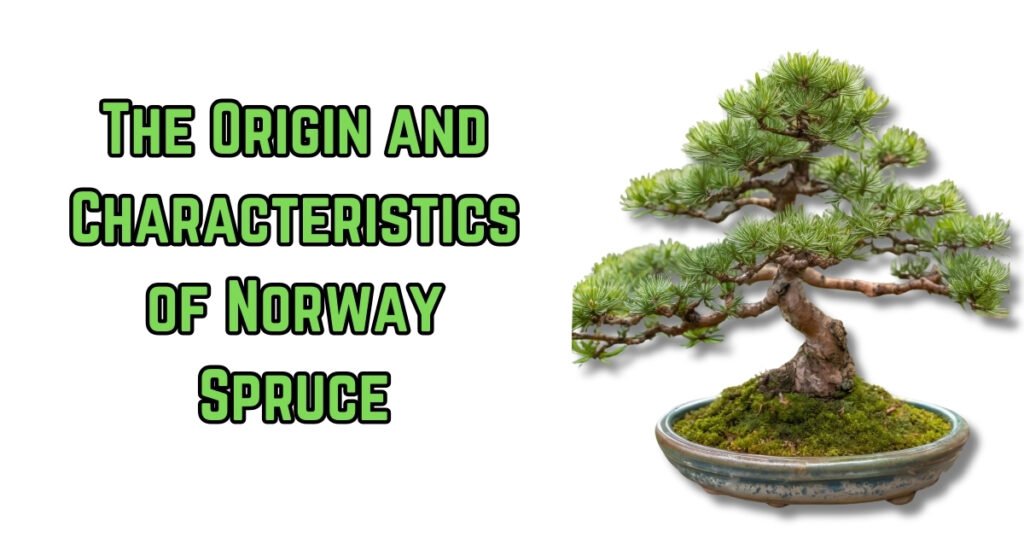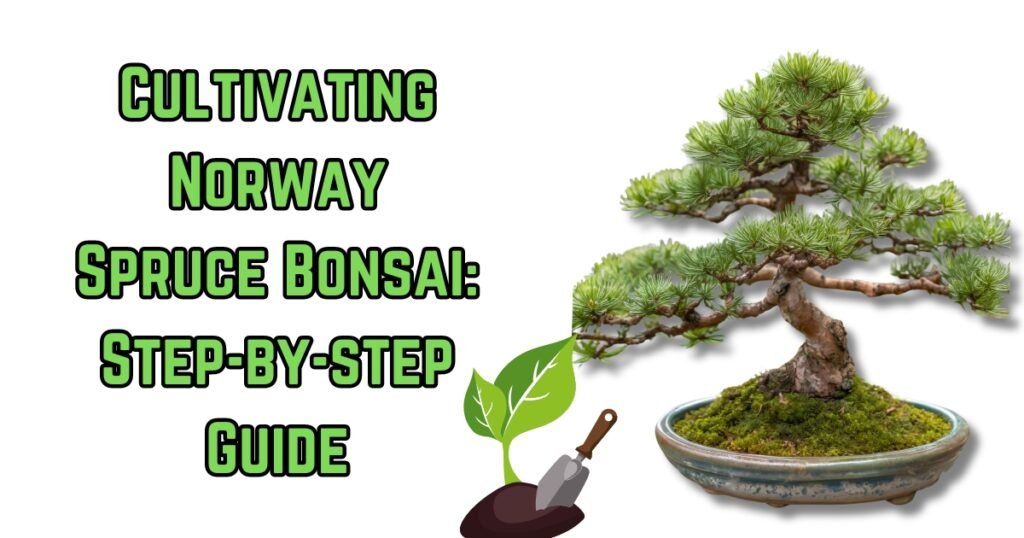Introduction
Are you interested in learning about Norway Spruce bonsai? Well, you’ve come to the right place! Norway Spruce is a popular bonsai tree species perfect for beginners and experienced enthusiasts. One of the best things about this tree is that it’s easy to care for and maintain.
Another reason Norway Spruce is so popular is that it’s an evergreen tree with reddish bark and needle-like leaves that remain on the tree for 4 to 10 years, making it visually appealing.
To keep your Norway Spruce bonsai healthy, ensure it gets full sun during the growth phase and semi-shade during winter. Although it can tolerate freezing temperatures, it may require frost protection when housed in a bonsai pot. It’s also important to water it thoroughly once the soil dries up, but be careful not to overwater it.
Regular fertilization, pruning, wiring, and repotting are essential for maintaining your Norway Spruce bonsai. However, styling might be challenging due to limited back budding and the tendency of branches to revert after wiring.
Lastly, like any other plant, your bonsai may be susceptible to common pests and diseases, such as aphids, spider mites, gall adelgids, and various fungal diseases. So, look for any signs of trouble and take action promptly.
| Care Aspect | Details |
|---|---|
| Sunlight | Full sun in growing season, semi-shade in winter |
| Watering | Thorough watering when soil dries up |
| Frost Protection | Necessary for bonsai pots in freezing temperatures |
| Fertilization | Every four weeks with solid organic fertilizer or weekly with liquid fertilizer |
| Pruning | Required to maintain silhouette and stimulate interior bud growth |
| Wiring | Necessary for shaping branches; rewiring may be required |
| Repotting | Every two to four years with slight root pruning and well-draining soil mix |
| Pests and Diseases | Aphids, spider mites, gall adelgids, and fungal diseases |
The Origin and Characteristics of Norway Spruce
Did you know that the Norway Spruce is a beautiful and resilient species that can survive in cold climates? This tree is excellent for bonsai and can be used as a Christmas tree.

The Norway Spruce Bonsai is especially remarkable for its unique aesthetics. It has a conical shape and beautiful reddish bark that adds a rustic charm to its appearance. Its glossy, needle-shaped leaves retain their healthy dark green color for 4 to 10 years, and the cones elegantly hang downwards, making it a sight to behold!
The Norway Spruce is an excellent choice for bonsai due to its strength, adaptability, and aesthetic appeal. Give it a try!
Cultivating Norway Spruce Bonsai: Step-by-step Guide

Propagation of Norway Spruce Bonsai:
Propagating your Norway Spruce Bonsai can be a rewarding process. The most common method is through seeds or cuttings:
- Seeds: All you need to do for seeds is plant them in good-quality soil and keep them nice and moist. To give them the best chance of germinating, it’s a good idea to provide them with a “cold winter” by placing them in an excellent spot for a few weeks before planting.
- Cuttings: Take a healthy branch from a plant you love during the growing season if you prefer to use cuttings. Dip the end in some rooting hormone, then plant it in a pot with well-draining soil. Keep the pot somewhere warm with indirect sunlight until you see roots starting to develop.
Ideal Conditions Required for Growth:
- When it comes to growing your bonsai, there are a few ideal conditions you should keep in mind:
- Your tree loves sunlight and gets plenty of it during the growing season.
- It can withstand freezing temperatures but may need frost protection if you’re growing it in a bonsai pot.
- A well-draining soil mix is crucial to prevent root rot.
Now, let’s talk about watering and feeding. Proper care in these areas is critical for the health and growth of your Norway Spruce Bonsai. Water thoroughly once the soil dries out, but be careful not to overwater. When it comes to feeding, fertilize your tree regularly with solid organic or liquid fertilizer during growth.
Care and Maintenance of Norway Spruce Bonsai
Here are some daily care practices that you should follow:

- Water the spruce thoroughly as soon as the soil gets dry. But make sure to avoid keeping the roots soaking wet all the time.
- Apply solid organic fertilizer every four weeks or use a liquid fertilizer every week during the growing season.
- Pinch new shoots in spring when they are still soft. Prune back long branches by shortening them to smaller twigs near the trunk.
- Bend and twist branches as needed, but avoid wiring in midsummer.
- Report the spruce every two to four years, slightly pruning the roots.
- Protect the tree from extreme elements and avoid fertilization after repotting.
Also, remember that your bonsai’s care needs will change with the seasons. Here are some seasonal care considerations to keep in mind:
- Place the spruce in full sun during the growing season and in semi-shade with frost protection in winter.
- Water lessens in winter and provides shelter from wind and extreme sun.
- Fertilize heavily for solid growth or lightly for refinement.
- Style spruces in late summer or early spring.
- Repot every two to four years or longer for older trees.
- Take cuttings in late summer for propagation.
Lastly, your bonsai can be susceptible to diseases such as Green Spruce Aphids, Spruce Spider Mites, Gall Adelgids, Spruce Needle Miners, Spruce Budworms, Rust, and Needlecast. But don’t worry; prevention is always better than cure. Regular inspection and proper hygiene can go a long way in keeping your bonsai healthy.
Styling and Pruning Techniques for Norway Spruce Bonsai
First, take some time to understand your tree’s natural shape and growth pattern. This will guide your styling decisions and ensure your tree remains healthy and vibrant.

There are several traditional bonsai styles, such as formal upright, informal upright, slanting, cascade, semi-cascade, literati, group planting, windswept, etc. Choose a style that suits your tree and your aesthetic.
Wiring and Shaping: Now, let’s talk about wiring and shaping. Use aluminum or copper wire to guide your tree’s branches into the desired shape. Always wire two branches of the same thickness together, and be careful not to damage the bark.
Advanced Styling Techniques
If you’re an experienced grower looking to take your bonsai to the next level, consider these advanced styling techniques:
- Layering: This technique involves inducing roots to grow on a branch still attached to the parent tree, creating a new tree.
- Jin and Shari: These are techniques used to mimic the effects of age and environmental stress on trees. Jin involves stripping the bark from a section of the branch to make it look like deadwood, while Shari removes a strip of bark from the trunk.
- Grafting: This technique involves attaching a piece of one plant to another, allowing it to grow as part of the new plant.
Pruning and shaping are essential components of bonsai care. Here’s a guide to help you navigate this process:
- Regular Pruning: This helps maintain the tree’s shape and encourages new growth. Always prune back to a healthy branch or bud, and make sure your pruning tools are sharp and clean.
- Structural Pruning: This is typically done in early spring and involves removing branches to improve the tree’s overall structure.
- Pruning Cones: Remove cones as they appear to prevent them from drawing energy away from the rest of the tree.
- Shaping: Use wire to shape your tree, but be careful not to damage the bark. Check the wire regularly to ensure it’s not cutting into the tree as it grows.
Remember, bonsai care takes time and patience. Each technique takes time, so take it slow and enjoy the journey!
Conclusion
The Norway Spruce Bonsai is popular among bonsai enthusiasts due to its unique aesthetic and resilience. To care for it, make sure it gets full sun during the growing season and semi-shade with frost protection in winter. Regular pruning and wiring will help maintain its shape and guide its growth. Water it thoroughly when the soil gets dry and report it every two to four years. Fertilize it regularly based on the season. Watch out for common pests and diseases. The Norway Spruce Bonsai is a great choice if you’re new to bonsai cultivation. With consistent care, you’ll have a living piece of art that provides a sense of accomplishment and tranquility.
FAQs
How should I position my Norway Spruce Bonsai?
The Norway Spruce Bonsai thrives in full sunlight but requires shade from mid-day sun during the summer. It’s a hardy tree that can tolerate wind and benefits from good air circulation.
What is the feeding schedule for a Norway Spruce Bonsai?
Feed your Norway Spruce Bonsai every two weeks throughout the growing season.
When should I report my Norway Spruce Bonsai?
It’s best to repot in late summer or early autumn after new buds appear on the current season’s growth.
How should I prune and wire my Norway Spruce Bonsai?
Pruning and wiring are essential for styling your bonsai. Hard pruning should be done in Autumn to reduce sap loss, and wiring should only be done in Autumn and Winter to avoid branch dieback. Remember that wired branches may take years to keep their new position.
Can I cultivate my Norway Spruce Bonsai indoors?
No, the Norway Spruce Bonsai requires a period of dormancy each year and cannot be cultivated as an indoor bonsai.
What species of Spruce Bonsai are there?
There are several species of Spruce Bonsai including Picea jezoensis, Picea glehnii, Picea abies (Norway Spruce), Picea engelmannii, Picea mariana, and Picea pungens.
What are common pests and diseases of the Spruce Bonsai?
Common pests and diseases include aphids, spider mites, gall adelgids, needle miners, budworms, and fungal diseases.
Further Reading and Resources
- The Quaking Aspen Bonsai: A Unique Artistry in Miniature Forestry
- Mastering the Art of Douglas Fir Bonsai: A Comprehensive Guide
- Exploring the Eastern Red Cedar as a Bonsai Choice
- The Revolutionary Practice of Hydroponic Bonsai: A Comprehensive Guide
- The Art and Science of Cultivating Honey Locust Bonsai: A Comprehensive Guide
- The Asparagus Fern Bonsai: A Unique Blend of Art and Horticulture
Other Sources
- Bonsai Empire [https://www.bonsaiempire.com/tree-species/spruce]
- Bonsaiable [https://www.bonsaiable.com/blog/norway-spruce-bonsai-tree-care]
- Bonsai Sui [http://www.bonsai-sui.com/conifer-bonsai/spruce-bonsai/]





